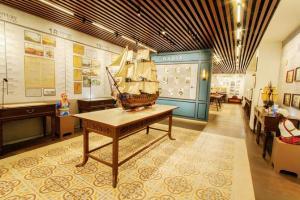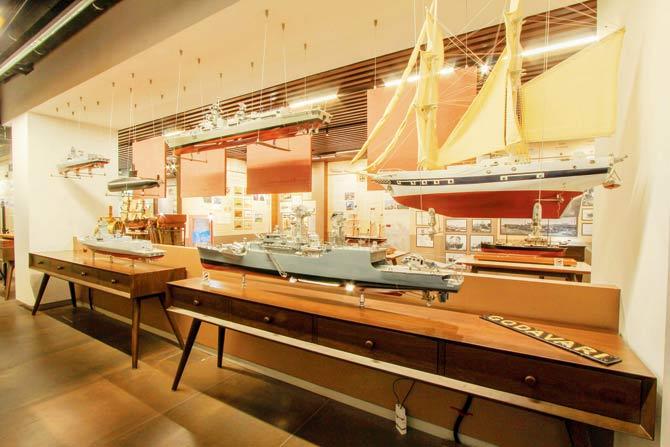On an exclusive tour of the city's oldest shipbuilding yard in Mazagon, Sunday mid-day sees technology and research come together at a revamped museum gallery that's a stunning tribute to India's maritime history

The museum gallery uses 3D elements, mixed media and original elements from ships like crests and nameplates, to keep the visitor engaged. Seen on the extreme left and right hand corners are replicas of mastheads
I don't wish to show up like a chokra boy," chuckles Kenneth James, paying no heed to a companion's advice to slip off his blazer on a muggy afternoon right before he steps in for a meeting with Commodore Rakesh Anand, Chairman and MD, Mazagon Docks Limited (MDL) . For Anglo Indians, "chokra boy" is a popular way to describe a good-for-nothing, unkempt youngster.
An hour earlier, James, 85 had hit rewind mode as he pored over years of history that grace the insides of Dharohar, the revamped maritime museum gallery at MDL. Accompanied by his daughters, Deborah O'Gorman and Annemarie Sharp, James was keen to visit the place where he spent the last years of teenage life. He had joined the Apprentice Engineers of MDL when he was 16 and completed the course in 1955. Playing his part in the gallery upgrade, James shared information on his training days with the experts team. "Uncle Ken [James] played a huge role in putting me in touch with the last of the Chinese fitters who were part of the skilled workforce at Mumbai's oldest shipbuilding yard, 60 years ago. I owe him a debt for loaning us his precious photographs, too," says Dr Fleur D'Souza, city historian and former HoD (History) at St Xavier's College.
ADVERTISEMENT
 Close ups of models of modern ships, including the INS Godavari (foreground) made from fibreglass
Close ups of models of modern ships, including the INS Godavari (foreground) made from fibreglass
At the gates of the high-security zone, Yogiraj Potnis, museum curator, takes on the role of guide, as we are led into a universe of hulls, beams and quarterdecks. The 200 sq ft gallery is a multi-dimensional state-of-the art space with wall-to floor graphics that carry nuggets of information, timelines, ship models and original nautical elements. Parvez Panthaky, former PRO, MDL, joins Potnis and D'Souza, collaborators on this 1.5-year-old project which was inaugurated by Defence Minister Rajnath Singh in September.
"You will see a meticulous chronicling of India's shipbuilding history, dating back to the 16th century, including a sub-section on Mazagon. There is an audio-visual available on how Mumbai's seven islands became one entity," shares Potnis. James and his daughters hang onto his every word as he takes them through fascinating episodes of the Wadia family of shipbuilders and their somewhat frosty equation with their colonial bosses. The stunning models of ships, from HMS Minden and HMS Trincomalee to modern-day submarines and minesweepers are of particular interest. "The wooden ones were crafted in-house, while the others, made from fibreglass, were commissioned," says Potnis. A rare, grainy frame of Charles II of England and Catherine of Branganza, whose marriage changed the history of Bombay, sits on one wall. We wonder what the larger-than-usual busts, including that of a pirate and a bedecked man, are doing in corners. "These are mastheads, and were positioned at the mast of ships. Since sailors were mostly illiterate, these distinctly shaped figures helped them identify their own ship," he reveals. We smile, thinking, this is just the sort of nugget a newspaper journalist waits to discover.
 (From left) The external team of experts included Yogiraj Potnis; Cdr Ninad Phatarphekar (veteran), Dr Fleur D’Souza and Abhishek Ray, Parvez Panthaky. Cmde TV Thomas from MDL also contributed
(From left) The external team of experts included Yogiraj Potnis; Cdr Ninad Phatarphekar (veteran), Dr Fleur D’Souza and Abhishek Ray, Parvez Panthaky. Cmde TV Thomas from MDL also contributed
The first innings of the museum gallery, we are told, were envisioned by Commodore Ninad Phatarphekar (veteran) and former employee at MDL and Panthaky after extensive study tours to the UK in 2014. Many concepts and ideas, including that of the mastheads, emerged from Kent's historic dockyard and Greenwich's National Maritime Museum. The gallery was inaugurated by late Manohar Parikkar in 2015. "The museum needed an upgrade; artefacts had developed moisture, and there was a plan in place to give it a 360-degree relook, so we all came together," Phatarphekar, tells us later over a phone call. The design is a refreshing departure from what was, embracing a minimal style this time around. This was possible thanks to architect Abhishek Ray's close connect with the core team. "Accommodating all the information within a restricted space was the main challenge. It is a curators' dream to keep it all in place, so, we worked out solutions at the brainstorming sessions," he says.
 Commodore Rakesh Anand
Commodore Rakesh Anand
A certain segment reveals how the opening up of the seas thanks to the Suez Canal saw the emergence of new commercial interests at Bombay harbour. The Peninsula & Oriental Steam Navigation Company as well as the British India Steam Navigation Company began operations, leading to new options for seafaring passengers in both continents. We've reached the 1950s, and James spots his photograph. He is posing with a batch of fitters from China. "There's dad!" says an excited Annemarie. It's a special moment, and a family photograph is captured against the black and white memory.
Through the next 30 minutes, we are treated to a range of pictorial vignettes from India's maritime milestones, as advances in technology witnessed an upgrade in ship and submarine building. Along the way, the expert trio regale us with fascinating anecdotes, including Bombay's love affair with ice and how it was shipped for parties from far-off Boston.

Kenneth James with daughters Deborah O’Gorman and Annemarie Sharp stand against the backdrop where James’ photograph with Chinese fitters from the 1950s form part of the display. Pics/ Mazgaon Docks Limited
We wait in an icy air-conditioned conference room for Commodore Anand to arrive. Good thing he didn't ditch his blazer, James laughs. Over chai and biscuits, the Indian Navy veteran hears the octogenarian narrate stories of dances and hockey matches at MDL and tricks of the trade that apprentices picked up, unheard of in today's times. "We'd be honoured if you could share these invaluable records for our digital archive," the Commodore requests.
"Unlike in the West, we don't have museums on shipbuilding in India. Considering that it was one of the earliest commercial ventures in Mumbai, this was a serious shortcoming we decided to fix," he says, about how the project set sail. "When the time came to enhance the existing gallery, we jumped at the opportunity. Research was a continuous process, and we had to decide when to stop," he smiles, as D'Souza nods. He turns to us, the lone journalist in the room, asking for our opinion. "Will it be open to the public?" we wonder.
"That this is one of the best researched and informative galleries of shipbuilding shouldn't stay a secret forever. We come under the Prohibited Area as per the Official Secret Act, 1923, and cannot open the place for general visitors. But we would like to open it to a discerning audience. In time, and with relevant permissions, we might consider opening it for a limited number of guests, including students," confirms the Commodore.
The US flag connect
American lawyer Francis Scott Key wrote the national anthem of USA, The Star Spangled Banner, on HMS Minden. It was the first royal ship built outside of the UK, by Wadia shipbuilders, and was launched from Bombay's Duncan Dock in 1810
Malabar is better
In the 1800s, there was a ban on oak wood. The East India Company had to look for alternate material to build ships and found that the Malabar teak was available and economical. The workmanship of the Wadias was superior, and hence, the ships for the Empire ended up being built by wood from India
A real dressing down
Thin and worn out sails were treated with oil or wax to make them hold the wind again. This was how the term 'dressing down' came into being. Thus, a sailor who was 'dressed down' was treated in a way by his officer, which would dramatically improve his performance
Catch up on all the latest Mumbai news, crime news, current affairs, and also a complete guide on Mumbai from food to things to do and events across the city here. Also download the new mid-day Android and iOS apps to get latest updates
 Subscribe today by clicking the link and stay updated with the latest news!" Click here!
Subscribe today by clicking the link and stay updated with the latest news!" Click here!







